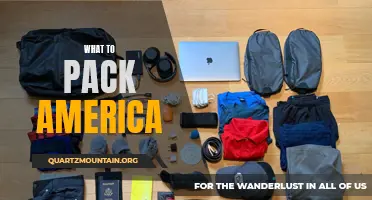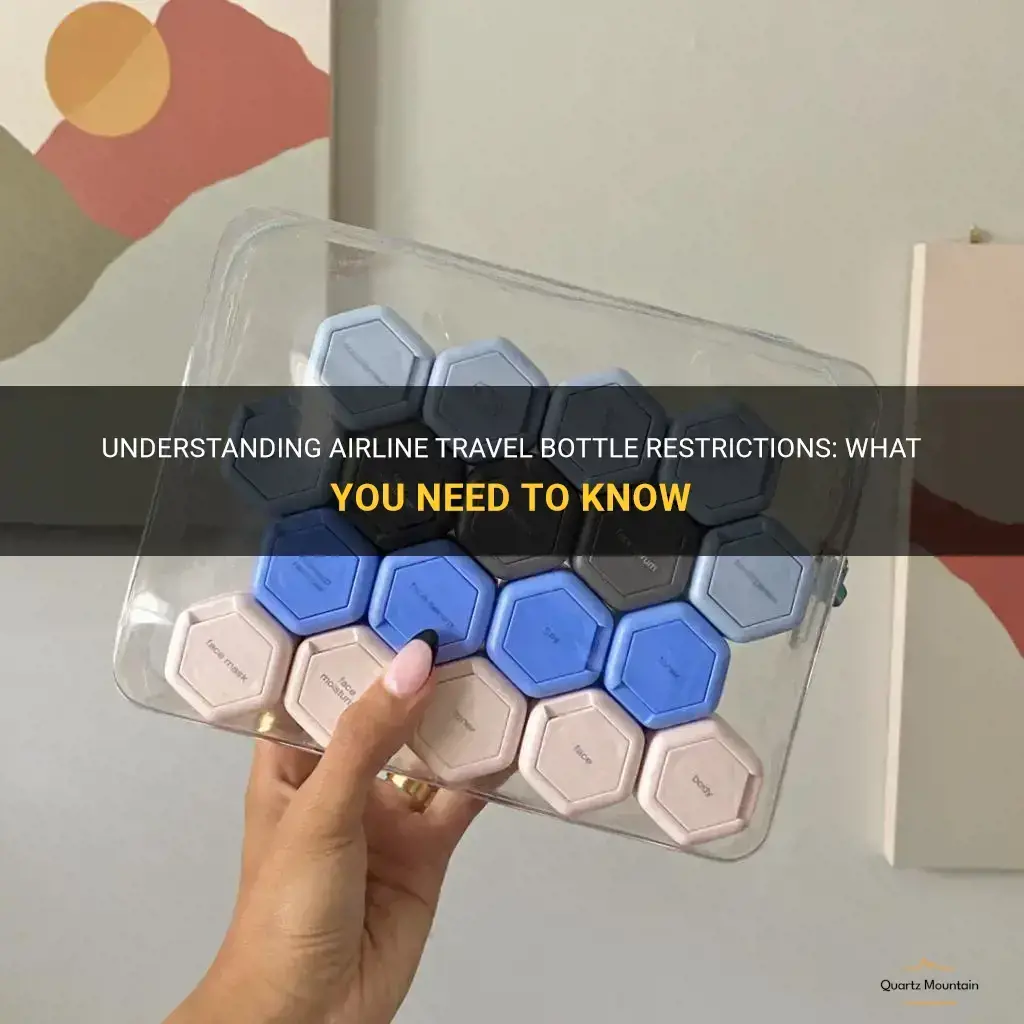
Have you ever wondered why there are such strict restrictions on the size of bottles you can bring with you on a flight? Airline travel bottle restrictions have become an essential part of security measures in recent years, but have you ever stopped to think about why they were implemented in the first place? In this article, we will explore the history and reasoning behind airline travel bottle restrictions, and why they continue to be important for ensuring the safety of air travelers.
| Characteristics | Values |
|---|---|
| Size | 3.4 ounces or 100 milliliters |
| Quantity | 1 quart-sized clear plastic bag |
| Liquids | Must be in containers |
| Containers | Must be 3.4 ounces or smaller |
| Bag | Must be clear and resealable |
| Bag Size | 1 quart or 1 liter in size |
| Exceptions | Medications, baby formula, and breast milk are allowed in reasonable quantities beyond the 3.4-ounce limit. |
| Carry-on Restriction | All liquids must fit in a single, clear, resealable bag and be placed in a bin or on the conveyor belt for screening. |
| Checked Baggage Restriction | No specific restrictions, but liquids should be securely packed to prevent leakage. |
What You'll Learn
- What are the current regulations regarding the size and quantity of bottles allowed in carry-on luggage for airline travel?
- Are there any specific restrictions on liquids, such as toiletries or beverages, in airline travel bottles?
- How do these bottle restrictions differ for domestic flights compared to international flights?
- Are there any exceptions or special considerations for passengers with medical needs that require carrying larger quantities of liquids in airline travel bottles?
- Can passengers bring empty bottles through security and refill them once they are past the security checkpoint?

What are the current regulations regarding the size and quantity of bottles allowed in carry-on luggage for airline travel?
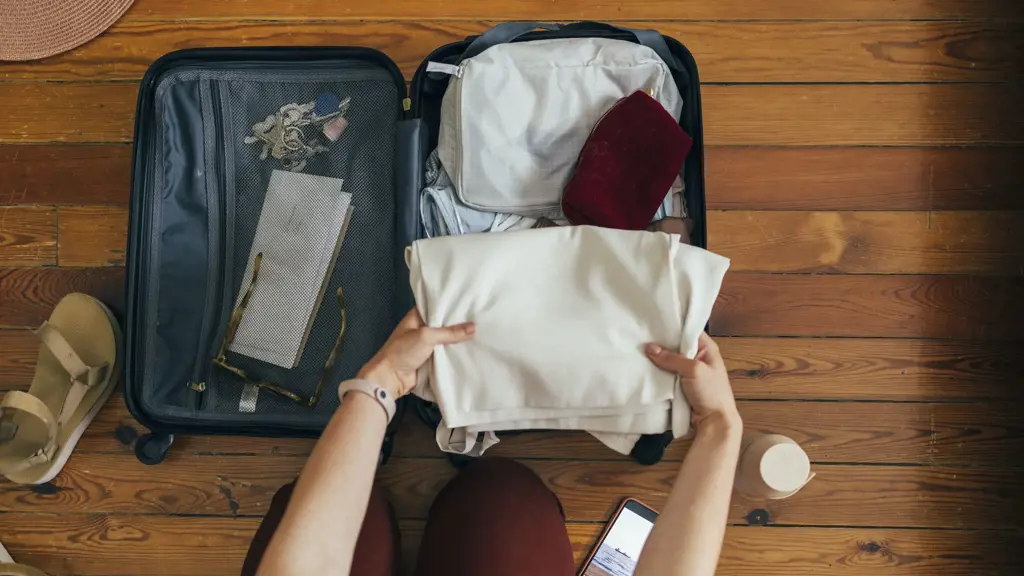
When it comes to airline travel, there are certain regulations and restrictions that passengers must adhere to in order to ensure a smooth and hassle-free journey. One area where many travelers may have questions relates to the size and quantity of bottles allowed in carry-on luggage.
The Transportation Security Administration (TSA) is responsible for overseeing the security measures in place at airports across the United States. They have specific guidelines regarding liquids, gels, and aerosols that are allowed in carry-on bags.
For liquids and gels, the TSA follows the 3-1-1 rule. This means that passengers are permitted to bring liquids or gels in containers that are no larger than 3.4 ounces (100 milliliters). These containers must be placed in a single, clear, quart-sized plastic bag. Each passenger is allowed one such bag, and it must be easily accessible for inspection at the security checkpoint.
It's important to note that the size of the container is what matters, not the amount of liquid inside. Even if a container is only partially filled, it must still adhere to the 3.4-ounce limit. Additionally, the quart-sized bag containing the liquids and gels must be able to close properly and fit comfortably in the carry-on bag.
There are some exceptions to the 3-1-1 rule. Prescription medications, baby formula, breast milk, and juice for infants or toddlers are allowed in reasonable quantities, exceeding the standard 3.4-ounce limit. These items should be declared to the TSA officer at the security checkpoint for inspection.
In terms of quantity, there is no specific limit on the number of 3.4-ounce containers that a passenger can bring in their carry-on bag. As long as these containers fit comfortably within the quart-sized bag, they are allowed. However, it's important to remember that the quart-sized bag must be properly sealed and easily accessible for inspection when going through security.
If a passenger wishes to bring larger containers of liquids or gels, they must be placed in checked luggage instead of carry-on bags.
It's worth noting that these regulations primarily apply to domestic flights within the United States. If you are traveling internationally, it's crucial to check the specific regulations of the airline and destination country, as they may have different rules in place.
Being aware of and following these regulations will help ensure a smooth and efficient screening process at the airport. By packing liquids and gels in accordance with the 3-1-1 rule and properly declaring any exceptions, travelers can avoid unnecessary delays and start their journey on the right foot.
The Essential Guide to Air Travel Restricted Items: What You Can and Can't Bring on a Plane
You may want to see also

Are there any specific restrictions on liquids, such as toiletries or beverages, in airline travel bottles?
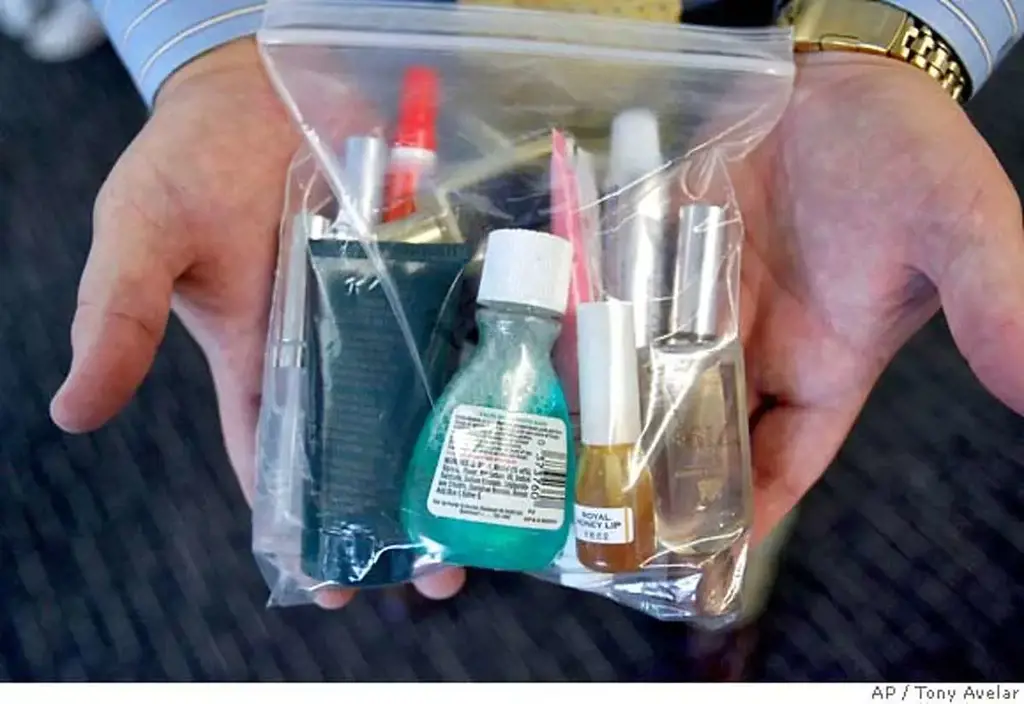
When it comes to traveling by air, there are specific restrictions on liquids that you can bring in your carry-on luggage. These restrictions are in place for security reasons and are implemented by airlines and airport authorities.
The most common restriction on liquids is the 3-1-1 rule. This rule states that passengers are allowed to bring liquids in containers that are 3.4 ounces (100 milliliters) or less in volume. These containers must be placed in a clear, plastic, quart-sized bag. Each passenger is allowed only one bag, and the bag must be able to close properly.
This rule applies to all types of liquids, including toiletries such as shampoo, conditioner, moisturizer, toothpaste, and deodorant. It also applies to beverages such as water, soda, and alcohol. It's important to note that the 3-1-1 rule applies to both domestic and international flights.
There are a few exceptions to the 3-1-1 rule. Prescription medications and baby formula/milk are allowed in larger quantities, as long as they are declared at the security checkpoint. Additionally, duty-free liquids purchased at the airport are allowed in larger quantities, but they must be placed in a secure, tamper-evident bag and accompanied by a proof of purchase.
When packing your liquids in airline travel bottles, it's important to ensure that the bottles are properly sealed to prevent any leakage. It's also a good idea to label the bottles to avoid any confusion or potential issues at the security checkpoint.
If you have liquids that exceed the volume allowed by the 3-1-1 rule, you have a few options. You can pack them in your checked baggage, as there are no restrictions on liquids in checked luggage. Alternatively, you can purchase travel-sized versions of your favorite toiletries or beverages, or you can wait until you arrive at your destination to buy what you need.
In conclusion, there are specific restrictions on liquids, such as toiletries or beverages, in airline travel bottles. The 3-1-1 rule limits passengers to containers of 3.4 ounces (100 milliliters) or less in volume, which must be placed in a clear, plastic, quart-sized bag. There are exceptions for prescription medications, baby formula/milk, and duty-free liquids. When packing your liquids, make sure they are properly sealed and labeled. If your liquids exceed the allowed volume, consider packing them in your checked baggage or purchasing travel-sized versions.
The Latest on Monaco Travel Restrictions: A Guide for Travelers
You may want to see also

How do these bottle restrictions differ for domestic flights compared to international flights?
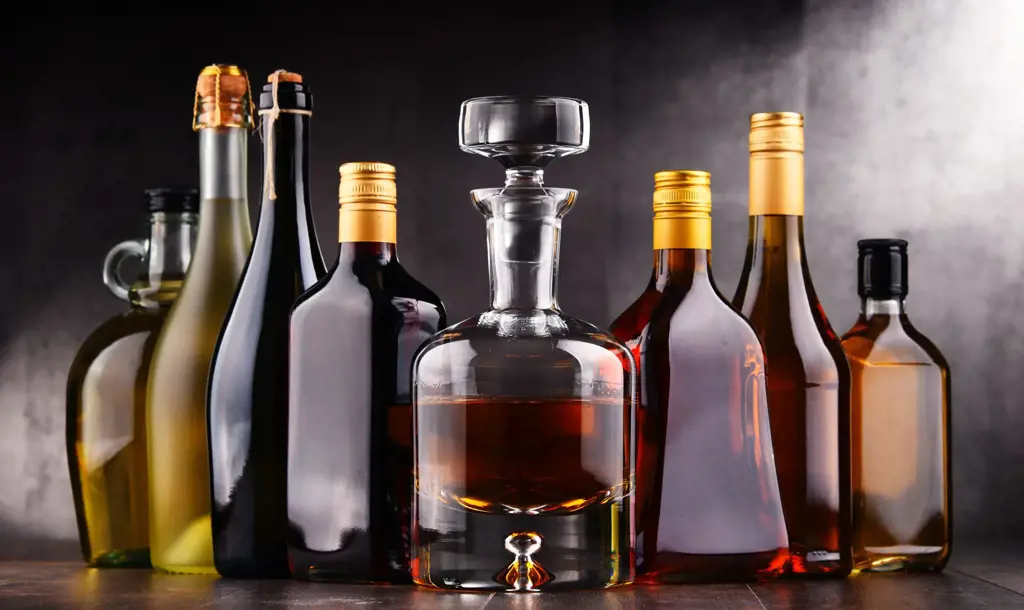
When it comes to traveling, it's important to understand the rules and regulations surrounding what you can and cannot bring on board. One common concern for many travelers is the restrictions on bringing bottles on flights. However, it's important to note that the restrictions for domestic flights differ from those for international flights.
For domestic flights within the same country, the Transportation Security Administration (TSA) sets the guidelines for what is allowed in carry-on luggage. The current rule states that passengers are allowed to bring bottles of liquid in their carry-on bags, as long as the bottle is 3.4 ounces (100 milliliters) or less. These bottles must be placed in a clear, quart-sized zip-top bag, with one bag allowed per passenger. This rule applies to all types of liquids, including water, beverages, toiletries, and cosmetics.
On the other hand, when it comes to international flights, the rules may vary depending on the airline and the country you are traveling to or from. While the TSA guidelines are a good starting point, each country has its own aviation security regulations that may be stricter or more lenient than those of the TSA. It's important to check with your airline or the embassy or consulate of the country you are traveling to for specific information regarding bottle restrictions.
In some cases, international flights may have similar bottle restrictions to domestic flights, where bottles of liquid must be 3.4 ounces or less and placed in a clear, quart-sized bag. However, there may also be additional restrictions on the type of liquids that are allowed, particularly when it comes to duty-free purchases or liquids purchased after passing through security. These restrictions are in place to maintain aviation security and prevent threats such as liquid explosives.
It's worth noting that even if a particular country allows larger bottles of liquid or has more relaxed restrictions, you may still be subject to the TSA's rules when departing from a U.S. airport. This means that any bottles of liquid you purchase from duty-free shops or onboard an international flight may need to be placed in a quart-sized bag and comply with the 3.4-ounce rule when you transfer to a domestic flight.
Overall, the bottle restrictions for domestic flights and international flights can differ, with each country and airline having its own set of regulations. It's crucial to check with your airline or the relevant authorities before traveling to ensure that you are compliant with all bottle restrictions and to avoid any inconvenience or delays during your journey.
Navigating Roatan Travel Restrictions: What You Need to Know
You may want to see also

Are there any exceptions or special considerations for passengers with medical needs that require carrying larger quantities of liquids in airline travel bottles?
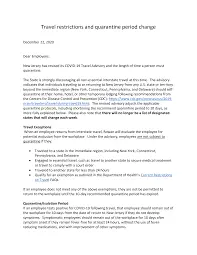
Passengers with medical needs that require carrying larger quantities of liquids in airline travel bottles may be subject to certain exceptions and special considerations. Airline travel regulations usually limit the amount of liquids that passengers can carry, following the "3-1-1 rule" which means each passenger is allowed to bring one quart-sized bag containing containers of liquids, aerosols, gels, creams, and pastes that are no larger than 3.4 ounces (100 milliliters) each.
However, for passengers with medical needs, there are provisions in place to accommodate their requirements. These exceptions are designed to ensure that passengers with medical conditions have access to the necessary liquids they need during their journey.
To qualify for these exceptions, passengers with medical needs must have a legitimate medical condition that requires them to carry larger quantities of liquids. This can include medications, medical devices, or medical supplies that are vital for their well-being. The specific requirements and procedures may vary among airlines and countries, so it is important for passengers to familiarize themselves with the rules and regulations of the airline they are traveling with.
In most cases, passengers with medical needs are required to provide documentation to support their request for carrying larger quantities of liquids. This documentation may include a letter from a medical professional explaining the medical condition and the need for the liquids, as well as any necessary prescriptions or medical certificates. It is advisable for passengers to carry these documents with them during their journey, as they may be required to present them at security checkpoints or when boarding the aircraft.
Passengers with medical needs should also inform the airline in advance of their travel plans to ensure that the necessary arrangements can be made. This may include requesting a wheelchair or assistance, pre-boarding privileges, or additional storage space for their medical supplies. Airlines are generally accommodating when it comes to passengers with medical needs, but it is important to communicate any specific requirements or concerns to the airline well in advance of the travel date.
It is worth noting that while passengers with medical needs may be allowed to carry larger quantities of liquids, they are still subject to certain restrictions. For example, the liquids must be in appropriate containers, properly labeled, and meet the security regulations of the airport and airline. It is advisable to consult the airline's website or contact their customer service department for specific guidelines on carrying medical liquids.
In conclusion, there are exceptions and special considerations for passengers with medical needs that require carrying larger quantities of liquids in airline travel bottles. Passengers with legitimate medical conditions can request permission to carry these items, but they must provide appropriate documentation and follow the guidelines set by the airline and airport. It is recommended for passengers to inform the airline of their medical needs in advance and to familiarize themselves with the specific regulations of the airline they are traveling with.
Understanding the F1 Visa Travel Restrictions: Everything You Need to Know
You may want to see also

Can passengers bring empty bottles through security and refill them once they are past the security checkpoint?
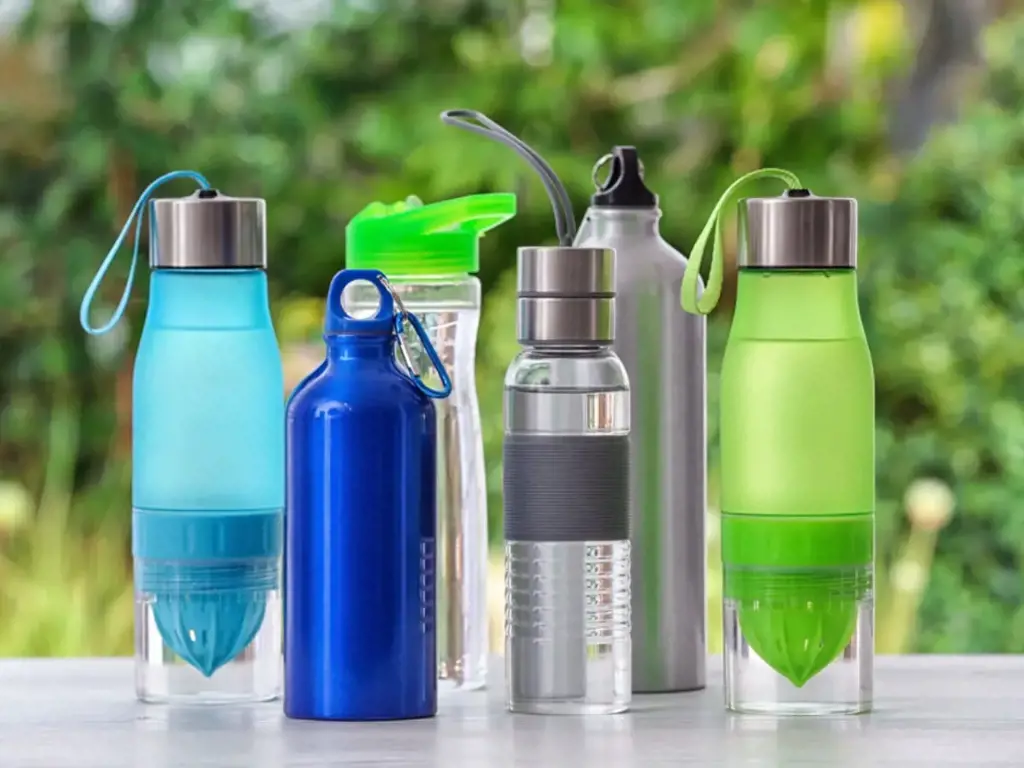
One of the common questions that travelers often have is whether they can bring empty bottles through security and refill them once they are past the security checkpoint. The answer to this question depends on the specific rules and regulations set by the airport and the Transportation Security Administration (TSA).
In general, passengers are allowed to bring empty bottles through security checkpoints. However, there are certain guidelines that need to be followed. The size and material of the bottle can make a difference. For instance, most airports allow plastic or metal bottles that have a capacity of 3.4 ounces (100 milliliters) or less. These bottles need to be placed in a clear, quart-sized plastic bag along with other liquid items.
Once the passenger has passed through the security checkpoint, they are free to refill their empty bottle with water or other beverages from water fountains, cafes, or other establishments within the airport. This can be a convenient way for travelers to stay hydrated without having to purchase expensive bottled water or other drinks after passing through security.
It is important to note that the rules and regulations may vary from one airport to another. Some airports may have stricter policies regarding the size and type of bottles allowed through security, while others may be more lenient. It is always a good idea to check the specific guidelines for the airport you are traveling through to ensure that you are in compliance with their rules.
In addition to the airport policies, the TSA also has regulations regarding liquids and containers in carry-on bags. These rules are in place to ensure the safety and security of all passengers. It is important to check the TSA website or contact them directly for the most up-to-date information on what is allowed in carry-on bags.
In summary, passengers are generally allowed to bring empty bottles through security checkpoints. Once they have passed through the security checkpoint, they can refill their bottles with water or other beverages. However, it is important to check the specific guidelines for the airport and the TSA to ensure compliance with their rules and regulations. By following these guidelines, passengers can enjoy a convenient and cost-effective way to stay hydrated during their travels.
Navigating the US Travel Restrictions Map: What You Need to Know
You may want to see also
Frequently asked questions
The current restriction for airline travel bottles is that they must be 3.4 ounces (100 milliliters) or smaller. This includes all liquids, gels, and aerosols that you bring on board the airplane.
Yes, there are a few exceptions to the 3.4-ounce rule. Baby formula, breast milk, and juice for infants or toddlers are allowed in larger quantities. You may also bring necessary medications in larger quantities, but you must declare them to the Transportation Security Administration (TSA) and they may require additional screening.
When packing your travel bottles, it is important to follow the 3-1-1 rule. This means that all containers must be 3.4 ounces or smaller and fit into a single quart-sized clear plastic bag. Each passenger is allowed one quart-sized bag, and it must be easily accessible for screening.
Yes, you are allowed to bring an empty water bottle through security. Once you have passed through the security checkpoint, you can fill up your water bottle at a water filling station or at a drinking fountain.
No, each passenger is allowed one quart-sized bag for their travel bottles. If you have more travel bottles that cannot fit into a single quart-sized bag, you will need to either transfer them to smaller containers or leave them behind.


